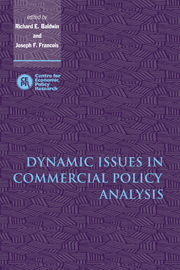Book contents
- Frontmatter
- Contents
- List of figures
- List of tables
- Preface
- List of conference participants
- 1 Introduction
- 2 Transition dynamics and trade policy reform in developing countries
- 3 Putting growth effects in computable equilibrium trade models
- 4 Innovation, capital accumulation, and economic transition
- 5 Multinational production, skilled labour, and real wages
- 6 Economic policy and the manufacturing base: hysteresis in location
- 7 Trade liberalization and investment in a multilateral framework
- 8 Investment creation and investment diversion: simulation analysis of the Single Market programme
- 9 Blueprints, spillovers, and the dynamic gains from trade liberalization in a small open economy
- 10 Trade policy and North–South migration
- 11 Long-term modelling of trade and environmental linkages
- 12 Labour markets and dynamic comparative advantage
- Index
3 - Putting growth effects in computable equilibrium trade models
Published online by Cambridge University Press: 13 January 2010
- Frontmatter
- Contents
- List of figures
- List of tables
- Preface
- List of conference participants
- 1 Introduction
- 2 Transition dynamics and trade policy reform in developing countries
- 3 Putting growth effects in computable equilibrium trade models
- 4 Innovation, capital accumulation, and economic transition
- 5 Multinational production, skilled labour, and real wages
- 6 Economic policy and the manufacturing base: hysteresis in location
- 7 Trade liberalization and investment in a multilateral framework
- 8 Investment creation and investment diversion: simulation analysis of the Single Market programme
- 9 Blueprints, spillovers, and the dynamic gains from trade liberalization in a small open economy
- 10 Trade policy and North–South migration
- 11 Long-term modelling of trade and environmental linkages
- 12 Labour markets and dynamic comparative advantage
- Index
Summary
Introduction
Many applied commercial policy analyses measure only the static effects of trade liberalization, despite the fact that most economists believe that the greatest benefits lie in the growth effects. Putting growth effects into computable trade models is, therefore, an important subject. This paper considers some of the analytical and practical issues involved in doing so. Before turning to the analysis, however, we set the stage by (1) briefly reviewing the basic logic of trade and growth, and (2) briefly reviewing the evolution of computable general equilibrium (CGE) models in order to put accumulation effects into perspective.
The logic of growth
If a nation's labour force is to produce more year after year, the economy must provide the workforce with more ‘tools’ year after year. Here ‘tools’ is meant in the broadest possible sense, i.e. of any type of capital, and we must distinguish three categories: physical capital (machines, etc.), human capital (skills, training, education, etc.), and knowledge capital (technology). With capital thus defined, it is plain that capital accumulation is what drives growth. Now capital accumulation is – for the most part – driven by private profit-motivated investment by firms and individuals. Consequently, the key to determining an economy's rate of growth is to study the costs and benefits of investment in human, physical, and knowledge capital.
This sequence of rather obvious statements directs our attention to the only way that trade liberalization can affect growth, namely via its impact on investment in machines, skills and technology. Some policies directly alter the rate of investment but, for the most part, they act on growth by changing the incentives facing private agents.
- Type
- Chapter
- Information
- Dynamic Issues in Commercial Policy Analysis , pp. 44 - 88Publisher: Cambridge University PressPrint publication year: 1999
- 4
- Cited by



